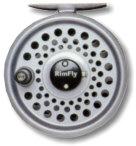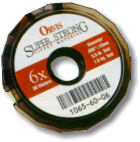For those of you who stumbled across this site by accident and have a mild or perhaps burning curiosity to know a little bit more, I offer this introduction to whet your appetite.
Basic Equipment

A graphite rod for a 5 or 6 weight fly line, 8 to 9 ft length. Rods come with 3 types of action- tip, tip to middle, and middle to butt. Choose tip to middle as a beginner with only one rod to handle the greatest variety of fishing conditions.


A 5-6 reel (based on line weight and rod match), unlike spin or bait casting, is not used in a fly cast. The line is stripped off the reel and then cast. So, an inexpensive but dependable reel, like the Cortland Rimfly, shown on the right, will handle most situations. I also show an Orvis Battenkill 5-6, as an excellent choice upgrade, moderately priced ($100 range). You'll need a lot more from a reel when you have larger fish on and cannot effectively control the line tension with your fingers, the fish will break off.
 |
Your line-DT(double tapered, so you can switch ends after wear & tear), WF(weight forward, for casting distance), 5 or 6 weight, F (floating). Start with this, you can add weight to sink the tip if you are nymph (wet fly) fishing or fishing wet flys on most rivers and streams. Later, you can add an extra spool for your reel with sinking or sinking tip line. Dacron backing is necessary and is added when you put the line on the reel. |
 |
 |
The leader attached to the fly line, is a tapered length of monofilament,
either in knotted sections, or knotless (continuous). It consists of 3
sections, the butt, middle, and the tippet, overall lengths ranging from
about 6 to 22 feet. Leaders are designated by tippet size. The higher the
x rating, the smaller, and more easily broken, the tippet. The tippet section
is about the last 2 to 3 feet of the leader, so that when a fish, or a
hooked log, breaks your line, you can tie on a new piece without having
to replace the entire leader. Most fly fisherman carry tippet spools from
3x to 7x.
 |
Finally comes the Fly! No, not this kind, but rather any one of the thousands of patterns created and tested over hundreds of years to fool the wily Salmo (trout). Flys are sized by hook size, ex: 6,8,10, 12,….22. A size 12 woolybugger is huge compared to a size 22 midge. Now before you run out and buy that prepackaged assortment of red, yellow and green feathers to stick in your hat, I suggest that instead, you pop into your local fly fishing store, tell them where you plan to fish, and follow their suggestions. |
Ok, I will mention a few flys that sooner or later you'll have to have, or at least be aware of, when you meet that first L.L. Bean type on your favorite stream. When he proudly announces that he just landed a four lb. Rainbow on a number 16 Adams, you can give him a knowing nod.
Adams, Elk Hair Caddis, Hare's Ear, Royal Wulff, damsel nymph, Pheasant Tail, Goddard Caddis, Woollybugger (in various sizes)
Whoa! You're almost, but not quite ready to go. A couple of other items are absolutely necessary before you step into that stream. A pair of snips (nail clipper) and a forceps (for removing the fly from all those fish you are nailing) are must have items. In fact, carry a spare nail clipper, if you lose one your teeth can get mighty worn, take it from one who learned the hard way. An old pair of sneakers or strap-on sandals will do in warm weather on up to knee deep water. Lastly, you must have at least one zinger. No one will believe you are a serious fly fisherman unless they can see a zinger.
Eventually, if you really get into it, you will need waders, wading boots, a vest , polarized sun glasses, leader straightener, float tube, fins, landing net, and countless other toys.
How much does it cost to get started? Take a look
at the  or
or  catalogue.
catalogue.